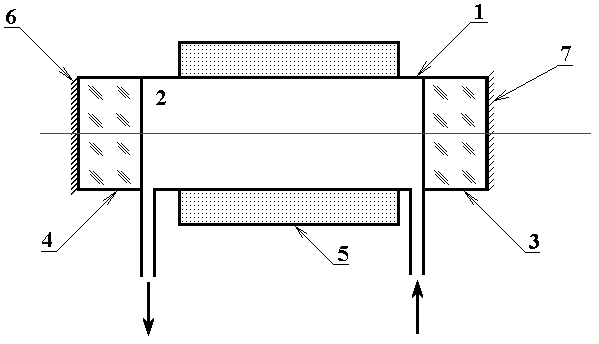
The group of inventions concerns to area of creation of the military lasers, working by means of pumping of active substance by thermonuclear reactions.
Now often enough in press appear the messages, in which the specialists discuss opportunity of use of lasers in military sphere (for struggle against of the rockets, of the planes, of the satellites). So the corporation the Boeing do the attempt to establish the chemical laser aboard the plane. The army of the USA do the tests of the military chemical laser on artillery range.
Common drawback of existing laser systems is necessity of use of powerful (cumbrous) sources or electric energy or tankage with chemical reagents, what makes heavier the general design of laser installations, increases their dimensions, reduces their mobility.
Technical result of the declared here of the group of inventions is use of the phenomena of a sonoluminescence and cumulation for reception of thermonuclear microexplosions which in turn create inverse population of levels in working substance of the laser.
Because we will use in offered group of inventions of the energy of thermonuclear reactions, then it is possible to refuse use in laser installations of external (bulky) sources of electric energy or tanks with chemical reagents.
And as consequence it we can make the general design of laser devices more simple, compact, easy and mobile. And the offered way allows to create lasers as frequentative action, so and of the once disposable lasers.
For the pulsing lasers with the frequentative action each thermonuclear microexplosion serves as an energy source, not only for a laser shot, but also by energy for preparation of following thermonuclear explosion therefore there is an opportunity of shooting by laser iterant volley (the laser submachine gun).
In this case it is possible to lead some analogy to work of automatic fire-arms (for example, submachine gun of Kalashnikov's) where each previous shot activates the weapons mechanism, sending a following cartridge in a cartridge-chamber.
For lasers of one-shot (blowing up during a shot) the presented group of inventions allows to simplify a design.
On a drawings 1, 2 and 3 I show the possible schemes of work of liquid lasers with nuclear excitation on a sonoluminescence

The figure 1.
On a figure 1 a number 1 specifies cylindrical container, in which exist flow of a liquid 2 (for example, heavy water), and she play the role of working substance of the laser. Besides we saturate a working liquid by the gases deuterium and tritium, and also the long-afterglow luminophors - the substances, capable to the luminescence, which can create laser radiation.
The butt-ends of the cylindrical container 1 is hermetically closed by corks 3 and 4, which made of transparent substance, for example, from glass or diamond.
On the outside of these transparent corks have mirror surfaces: a mirror with full reflection 6 and a semitransparent mirror 7 which form the resonator.
Excitation of active substance of the liquid laser we carry out by the nuclear microexplosion arising owing to collapse of the cavitational cavities on a geometrical axis of a cylindrical sound oscillator 5.. The radioactive emanations, which ensue of the nuclear microexplosion, induce radiation of the luminophor, which is in a liquid, and if the geometrical parameters of the optical resonator, formed by mirrors 6 and 7, are picked correctly up, then along an axis of cylindrical container arises laser radiation.
Work of other laser system is presented on a figure 2.
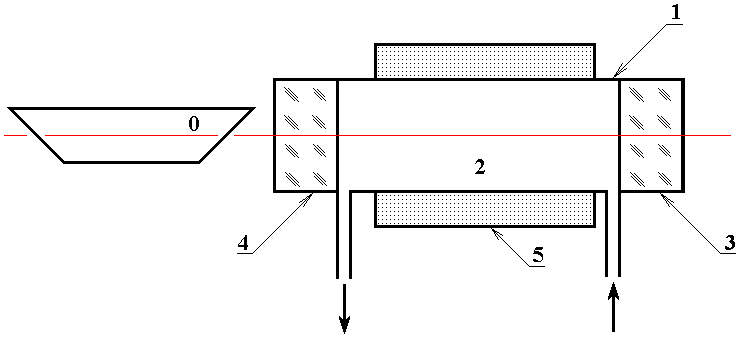
The figure 2.
In this case the device, in many respects is similar to the first device, which was shown on a figure 1. However in this case the device already has no own mirrors (has no own resonator), and is used only as the amplifier of a primary laser impulse, from the laser 0.
The third design of the liquid laser, with creation of population inversion by means of the phenomenon of a sonoluminescence, is given on a figure 3.
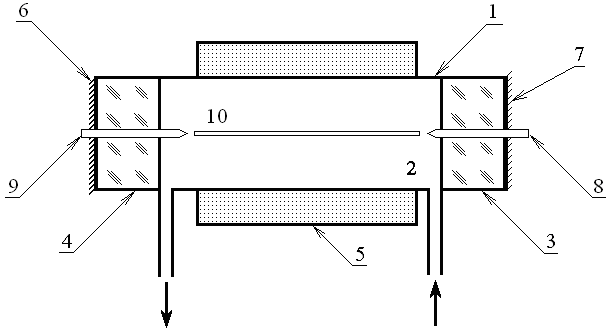
The figure 3.
We create in a cylindrical container 1 the flow of the dielectric liquid 2, which saturate by gases of deuterium, tritium and luminophor. On a geometrical axis of a cylindrical container 1 coaxially two metal shanks (electrodes) 8 and 9, to them through the metal coverings of mirrors from an external high-voltage source we direct the bipolar electric impulses Cycles of work of a cavitational nuclear reactor with the dielectric liquid have been in detail described by me earlier (the reader can look the description of a reactor once again). Therefore here I only do the remark: the laser ray get off through a semitransparent mirror 7 around of a shank-electrode 8.
The general scheme of the power equipment of liquid lasers with use of the phenomenon of a sonoluminescence is presented on a figure 4.
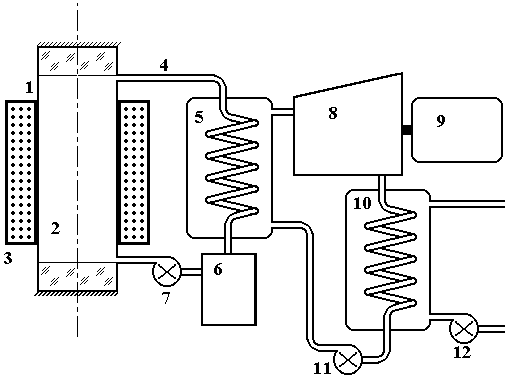
The figure 4.
She reminds the classical scheme of a uranium reactor. Single difference in this case there will be in that, what instead of a uranium or plutonium nuclear reactor we used the liquid laser, with thermonuclear a pumping , which the caused by nuclear microexplosions during collapse of cavitational cavities.
Occasionally in literary articles it is underlined, that some experiments with processes of a sonoluminescence are accompanied by allocation of additional "superfluous" energy without radiating radiation (probably, here we observe the exist in a microcosm of some new physical phenomenon, accompanied by allocation of energy , however this energy is allocated not as a result of thermonuclear reactions). In this connection the schemes of devices, which we considered here, can be used for creation of laser radiation and without thermonuclear reactions, i.e. without an output of radiation. That opens an opportunity of creation on the presented principles of the compact laser weapon of the frequentative action transported by the infantryman - laser automatic gun, rifles, pistols.
The phenomenon of a sonoluminescence together with the phenomenon of a cumulation opens an opportunity to create more simple in a design the thermonuclear blasting assembly and consequently allows to simplify a design of the single (blowing up during a laser shot) x-ray lasers of space basing.
According to this method the thermonuclear device consists of following components (see a figure 5) where the slit is shown):
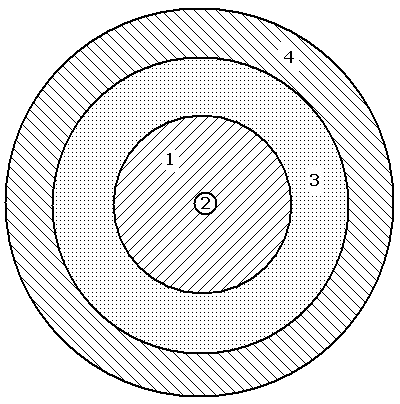
The figure 5.
Cylindrical or spherical (by the external form) volume of substance (it is designated on a figure as the number 1) which consists only of such chemical elements which are capable to serve as energetically favourable fuel for reactions of nuclear synthesis, for example, from
6LiD.
In the geometrical center of symmetry of thermonuclear explosive substance 1 there is a cavity in advance made by means of the mechanical instrument (on a figure this cavity is designated by the number 2).
Around of thermonuclear explosive the layer of usual chemical explosive, on a image it is marked as by the number 3.
The all this device is concluded in a strong metal environment (4).
(Here in addition possible use of the covering, which is reflecting neutrons inward of the device, but we shall not do discussion of such details).
Operation of the nuclear device occurs as follows:
At central-symmetric, in case of the spherical form of thermonuclear explosive, (or at axially-symmetric, in case of the cylindrical form of thermonuclear explosive) the undermining of chemical explosive (3) occurs central-symmetric (or axially-symmetric) implosion (explosion inside) of the nuclear explosive (1). Therefore in nuclear explosive will extending from periphery to the center of symmetry with gradually incremental speed the shock wave, which strikes in walls of a gas cavity (2), making her collapse.
(As a matter of fact here will exist the phenomenon of a sonoluminescence in a strong solid.)
Thus on the final stage collapse of gas cavities we developed temperature and pressure, which sufficient for the begin of the thermonuclear reaction.
Then in the reaction of nuclear synthesis will entered of the layers of thermonuclear explosive earlier close adjoined to a cavity strongly compressed by chemical explosion that liberates a new portion of energy owing to what thermonuclear reaction is entered with following layers of nuclear explosive, etc. - uncontrollable nuclear explosion turns out.
The similar way of realization of the uncontrollable thermonuclear reaction will allow to refuse in a thermonuclear ammunition from use of the high-enriched stuffing by a uranium or plutonium, what considerably will simplify a design and will lower cost of a thermonuclear ammunition.
In the given concrete case the offered way will allow to simplify a design of the x-ray laser of space basing, with the pumping carried out by nuclear explosion.
The many modern designs of a nuclear ammunition imply for activation of nuclear reactions (achievement of critical weight or critical density) use of the phenomenon of implosion - " explosion inside " by means of chemical explosive
Thus very important to organize geometrically correctly process of implosion of the chemical explosive. For this purpose usually use complex system of the special electronic detonators, which install in thickness of chemical explosive.
The method, offered here, allows to refuse in a nuclear ammunition this system of separate electronic detonators, having replaced with their thin metal wire, which we can detonate along all length with help of a quick greater impulse of an electric current.
So, if nuclear explosive has the form of sphere, then coils of a wire (see a figure 6) in thickness of the chemical explosive we should do as a single-layered spherical framework (in centre of the it of the spherical spiral is a nuclear explosive - uranium 235, plutonium 239 or sphere from 6LiD, with a cavity in the geometrical center of symmetry).
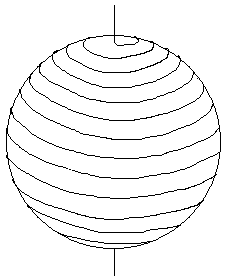
The figure 6.
In the event, if the nuclear explosive has the cylindrical form (the cylinder of the 6LiD, with a cylindrical cavity along an axis), then the coils of a metal wire in chemical explosive have the form a single-layered framework of the cylindrical form, for example, like the solenoid (see a figure 7, where number 1 marks the nuclear explosive, the number 2 is coils of a wire, in thickness of chemical explosive, at the same time the coils of a wire should be equidistant from a surface of nuclear explosive.
The figure 7.
We do the detonation of the chemical explosive by means of the quick greater impulse of an electric current, which passed through our a thin metal wire.
The wire simultaneously - on all length - evaporates (blows up), i.e. she be converted in the high-temperature plasma framework, symmetric to a surface of nuclear explosive.
Thus can be made the detonation of the chemical explosive, and then the form of a blast wave extending in thickness of chemical explosive substance it will be good to correspond to geometry of a surface of nuclear explosive, what will allow to make qualitatively implosion.
The official site, here is described work of the liquid laser with a nuclear pumping, on reactions of uranium fission.
The site of magazine "YT" 11 for 1992 - in detail describes manufacturing techniques of the liquid laser, ways of its adjustment.
The site, where it is described so-called Z - machine - system of blowing up wires.
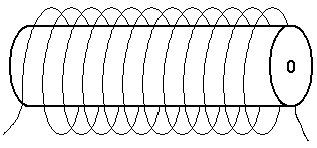
For additional acquaintance with the information on these questions, you can also look the following sites:
Сайт управляется системой uCoz